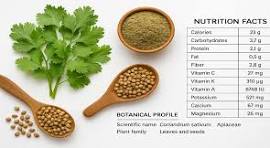What is Koriandri?
Koriandri has been valued as both food and spice since ancient times, and it continues to play an important role in kitchens and cultures today. Known in some regions as coriander or cilantro, it is the same plant with bright green leaves and small round seeds. Koriandri is used both as a herb and as a spice, making it one of the most versatile plants in the culinary world.
What Does Koriandri Look Like?
The Koriandri plant has soft green leaves that may resemble parsley at first glance, but its fresh, spicy, and sometimes lemony aroma makes it unique. It can grow up to 60 cm tall and produces delicate white or pink flowers. Once the flowers fade, they form small round seeds that are widely used as a spice.
Where Does Koriandri Grow?
Originally native to warm regions of Asia and the Mediterranean, Koriandri is now cultivated around the globe including Europe, Africa, the Americas, and Australia. It thrives in sunlight and grows best in rich, soft soil. Because of its easy care, many people also grow it in pots at home, ensuring a constant supply of fresh leaves.
See Also
Tasty Ways to Enjoy Lyposingrass and Boost Your Wellness
Koriandri in the Kitchen
The popularity of Koriandri comes from its distinctive flavor. Both parts of the plant are used in different ways. Fresh leaves, often called Koriandri greens, are sprinkled over soups, salads, noodles, and hot dishes. The dried seeds are ground into a spice with a warm, slightly sweet, and spicy taste that is often added to bread, sauces, curries, and spice mixes.
Why is Koriandri Popular?
Beyond its culinary uses, Koriandri is highly valued for its health benefits. It is rich in vitamins like Vitamin C and Vitamin K as well as minerals such as iron and magnesium. The essential oils in its leaves aid digestion, boost appetite, and add a refreshing aroma to dishes.
The Unique Taste of Koriandri
The strong flavor of Koriandri makes it a favorite for some and less appealing to others. Research shows that certain people have genetic traits that make the leaves taste soapy, while others enjoy its fresh, citrus-like taste. Despite this difference, Koriandri remains one of the most widely used herbs in global cuisine.
Koriandri Around the World
Different regions use Koriandri in unique ways. In Asia, fresh leaves are added to soups and noodles. In Europe, seeds are used in bread, sausages, and sauces. In South America, fresh leaves are blended into sauces and salsas. In the Middle East, seeds are an essential ingredient in spice blends and hearty stews. This global reach highlights how Koriandri connects cultures through food.
Growing Koriandri at Home
Koriandri is simple to grow, making it a favorite for home gardeners. Even small pots can provide enough leaves for daily cooking. Children and families enjoy growing Koriandri because it grows quickly and adds freshness to home meals.
Koriandri in History
The history of Koriandri stretches back thousands of years. Ancient Egyptians, Greeks, and Romans all used the plant for food and medicine. Seeds of Koriandri have even been discovered in ancient tombs, a sign of its cultural and nutritional importance.
See Also
Prostavive Colibrim: A New Era in Prostate Health and Natural Wellness
Koriandri and Health Benefits
Studies and health reports confirm that Koriandri is packed with valuable nutrients. While it is not a substitute for medicine, it contributes to a balanced diet. Vitamin C strengthens the immune system, Vitamin K supports healthy bones and blood, iron helps form red blood cells, and magnesium contributes to muscle and energy function.
Why Koriandri is Special
Koriandri is more than just a plant. It represents a connection between taste, history, health, and tradition. It is easy to grow, enhances food, and has been valued for thousands of years. Whether added fresh to a dish, used as dried seeds in recipes, or appreciated for its history, Koriandri continues to be a natural treasure.
Conclusion: The World of Koriandri
Koriandri is a small plant with a big impact. It is used across continents, has enriched diets for centuries, and continues to bring both flavor and health benefits to meals. From kitchen gardens to ancient traditions, it shows how deeply plants are woven into human culture. The next time you taste Koriandri, remember it is not just a flavor but a piece of history and heritage.
FAQs About Koriandri
Q1. What is Koriandri?
Koriandri is another name for coriander (Coriandrum sativum), a plant used worldwide as both a herb and a spice.
Q2. How is Koriandri used in cooking?
Fresh Koriandri leaves are used as garnish or flavor enhancers in soups, salads, and sauces, while the dried seeds are ground into spice blends, curries, and baked goods.
Q3. What are the health benefits of Koriandri?
Koriandri contains Vitamin C, Vitamin K, iron, and magnesium. It supports digestion, strengthens immunity, and contributes to overall health.
Q4. Can Koriandri be grown at home?
Yes, Koriandri grows well in small pots or gardens with enough sunlight and water. It is easy to cultivate and produces fresh leaves quickly.
Q5. Why do some people dislike the taste of Koriandri?
Some people have genetic differences that make the taste of Koriandri leaves seem soapy. For most people, however, it has a fresh, lemony flavor.
Q6. Why has Koriandri been valued for centuries?
Koriandri has been used since ancient times for food, medicine, and rituals. Its presence in historical tombs shows its cultural and nutritional significance.


